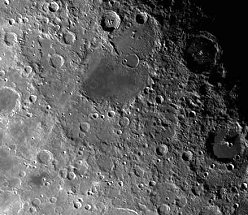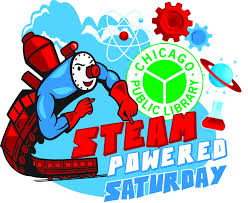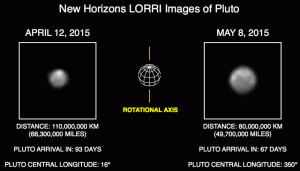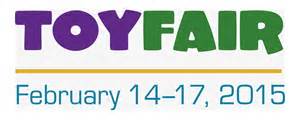Explore and Soar: Rahm’s Readers Summer Challenge & Moon Rocks!
I have done some pretty cool and awesome STEM presentations, workshops, and activities over the years. This summer it was super awesome as I connected with the Chicago Public Library’s Explore and Soar: Rahm’s Readers Summer Challenge. The library branches that I have visited and presented so far this summer have all been incredible and I had an extra special presentation to share with the young people and their parents, NASA Lunar samples! 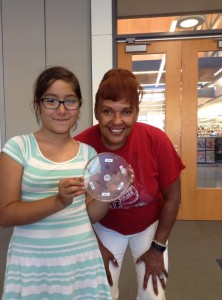
The Lunar samples (Moon Rocks) have been a big hit and a huge draw. When was the last time you could tell someone, “I held rocks and soil samples from the Moon!” They are encased in a thick piece of Lucite however there are also two Earth rock samples, Basalt and Anorthosite, two igneous (volcanic) rocks that allow you to hold, examine, and then compare rock samples from Earth to those found on the Moon by NASA astronauts. When I talk about careers in STEM, I cover engineering, astrophysics, astronomy, scientists, mathematicians, robotics, coding, and a host of others but next to astronomy, geology is by far one of my favorite subjects.
Careers options for geologists at NASA and many other institutions and organizations that look at geological processes, land formation, and topographical studies, and others rely on people who know their rocks and the job possibilities are wide open. During my library presentations, I talk about rocks and allow the audience to make their own hypotheses as to how the samples brought back from the Moon are the same as the samples found on Earth. The Lunar samples have allowed us to take previous hypotheses we had about what the moon was made of to concrete factual evidence. Yes, the Moon is a large Earth rock!
Read more about the event that broke off a piece of the Earth and created our Moon as well as how NASA is looking at ways to help us learn more about the similarities of rocks on the Moon and here on Earth.The summer reading challenge has opened up space as a career possibility for all the young people who have participated in the reading challenge and the activities that have been hosted at various Chicago Public Library branches throughout the summer that have enriched their opportunities to learn about space, space exploration, and STEM topics. The Explore More, extension of the summer program into August, has given me the opportunity to spread my love for space and all things NASA across the City of Chicago with so many wonderful young people and their parents.
I have four more presentations in the summer Explore More August series at branches across Chicago. If you can, bring the family, come out, meet me and the Lunar samples. Much thanks to NASA’s Johnson Space Center for allowing me the opportunity to bring these truly special samples to the public in Chicago!
For more information, visit chipublib.org. Pam Greyer—The NASA Lady—will be presenting her program at the following branch locations:
Tuesday, August 18 at 10:30 AM
Thurgood Marshall Branch
7506 S. Racine Ave.
Wednesday, August 19 at 6:15 PM
Beverly Branch
1962 W. 95th St.
Monday, August 24 at 1:00 PM
Dunning Branch
7455 W. Cornelia Ave.
Tuesday, August 25 at 11:00 AM
Rogers Park Branch
6907 N Clark St.
STEAM Powered Saturday: A Plutopalooza Celebration!
It’s always awesome when I get to share my love of science and our Solar System with others. On Saturday, May 30 I spent the day with staff from the Chicago Public Library as part of their STEAM Powered Saturday at the Harold Washington Library Center and talked to many young people and their parents who stopped by to meet The NASA Lady and learn about Pluto and the New Horizons mission The NASA’s New Horizons mission was the spotlight of the day and the beginning of many Plutopalooza celebrations that I will be a part of this summer. It has been interesting to watch and listen to reactions from people when they talk about Pluto.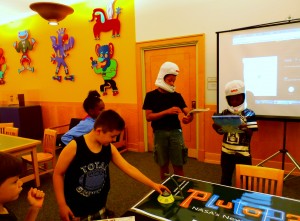
The once proud, yet small, 9th planet in our Solar System became a trending topic in August of 2006 when the International Astronomical Union (AIU) met and decided to downgrade Pluto to “Dwarf Planet” status because it did not meet all three criteria the AIU uses to define a full sized planet. It met all but the last criteria which requires a planet’s neighboring region to be free and clear of other objects. This would be really hard for Pluto because it is located in the Kuiper Belt and there are lots of other object near it.
Many people do not know or even care how this decision came about but they are all quick to join in the conversation and voice their opinion on the issue. Most people feel sorry for Pluto losing its designation as a planet while others believe that Pluto is simply gone. I learned this first-hand during my presentation when I asked people what they knew about Pluto. I got two really interesting responses: “It’s not part of our Solar System anymore” and “It blew up and it’s gone.” My presentation corrected these misconceptions but there are lots of people out here who still believe somehow in Pluto’s demise.
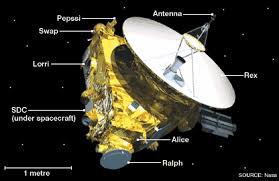
Image Courtesy of NASA/Johns Hopkins University Applied Physics Laboratory/Southwest Research Institute
In the meantime, we are preparing for a real treat. New Horizons has begun sending images back. Here are all images from the LORRI instrument on the New Horizons probe.
New images will be available on the website as they are received.Save the date, July 14, 2015, to witness clear pictures of Pluto. The discoveries that we’ll find on Pluto will be like presents wrapped up under the Christmas tree. Each image will be special and put Pluto a lot closer to our hearts.
Thanks to the New Horizons team lead by principal investigator Alan Stern and the excitement New Horizons is generating for everyone on Earth.
Sign up for the Pop-Up STEM Newsletter to find out where my Plutopalozza events will be popping up this summer!
Toy Fair 2015
Toy Fair 2015 is underway at the Javits Center in New York City. The largest toy show, open to the trade only, is where you can see previews of the hottest toys slated for release later this year as well as classic favorites, nostalgic toys, and the newest wave of technology powered play. We are doing interviews, product reviews, and putting special attention on toys and products that have a STEM focus. We are incredibly excited for the possibilities that lay before us in partnering with brands that will inspire and engage young people to embrace the concept of creative and innovative play while becoming immersed in science, technology, engineering, and mathematics.
Brands on our list that will be highlighted during the show are: Mattel, LEGO, McFarlane Toys, Wicked Cool Toys, Makey Makey, and a super list of other great toy companies. Stay tuned for live streaming, interviews, and really cool news coming from Toy Fair
Why Be An Engineer?
It’s interesting that I have been involved in STEM programs for the last twelve years and I have publicized, energized, and lately evangelized the importance of why we need, as a community, a city, a country, and even globally, to promote young people becoming excited about STEM and STEM careers. I was a product of involving girls in STEM in the 1960’s thanks to my father. He wasn’t an engineer but he supported my interest in science and moving things like trains, microscopes, and even that silly Mattel Creepy Crawler “Thing Maker.” “Girls don’t play with trains,” my mother told me when I was in high school as she attempted to reason with me to give my classic American Flyer train set away to my male cousin. “I never understood why your father gave you that train in the first place.”
She didn’t understand but at least I was able to keep putting the train up under the Christmas tree every year which kept her from secretly packing it up and giving it away as she did with many of my childhood toys and dolls. I was unaware that there was a career field called engineering and perhaps if I had known, I would have had an alternative in deciding to change majors in college. Engineering was an exclusive field that didn’t make it into the conversations or presentations in my high school. Perhaps the boys in the Physics class, an upper class elective, knew about engineering. The rest of us, however, were left aspiring to be doctors, lawyers, police officers, firemen, nurses, accountants, and other professions that we had been exposed to in elementary school and in our homes. I can’t remember ever hearing anyone talk about engineering in career day talks, college fairs, or in my high school counselor’s office. My mother worked for Delta Airlines. She wasn’t a mechanic, or an aeronautical engineer. She worked the public side of the airline industry. I never thought to ask her about the other side of the business and in her career day talks, I wonder if any students ever asked her about becoming a pilot, an airplane engine mechanic, or a designer of commercial aircraft.
Fast forward thirty years. In 1993, Congressman Louis Stokes of Cleveland, Ohio, concerned that minority students weren’t pursuing science and mathematics, worked with NASA’s Lewis Research Center and Cuyahoga Community College to create SEMAA (Science, Engineering, Mathematics, and Aerospace Academy). SEMMA was a STEM program at a time when nobody was calling science and mathematics STEM. The Internet was still a text based network with no images or color. Technology was computer science and Basic and Fortran were the programming languages being taught. Engineering, alas, was still not in the picture in most career awareness presentations. By the mid 2000’s, STEM started becoming the new buzz word. Unfortunately, as with all buzz words, many people and organizations, even many educational institutions, did not know how to properly implement STEM. I’ve judged science fairs that are now called STEM fairs where student projects had no engineering component in them anywhere. Now fast forward another twenty one years. As STEM has moved from an acronym that in 1993 was an obscure term used to encourage underrepresented and under-served populations to look at and become engaged in science and math in new, more engaging ways to stop that, “I hate math, I hate science,” mentality because “It’s hard,” into making STEM fun, exciting, interesting, imaginative, and purposeful. My question to everyone out there who has turned their science programming into STEM programming is, “Is it purposeful?” Are you working towards an end goal that will really inspire young people to WANT to go to college and major in a STEM career field and graduate then pursue a STEM career or are you just capitalizing on the acronym to gain funding, media attention, and student participation that costs parents and a year or two later those students are playing soccer, joining cheerleading and pom-pon squads, playing basketball, or involving themselves in other activities that are far removed from anything science, technology, mathematical, or technologically relevant. This is why, forty-five years after the United States landed on the Moon, we still have a huge shortage of qualified individuals in this country to fill the thousands of engineering jobs that are available.
Here is a blog post from Exon Mobile explaining why we need engineers. Let’s hope it doesn’t take us another forty-five years before we take the need to inspire and engage our youth to pursue engineering as a career.
Why Be An Engineer
America has a problem: Not enough U.S. students are pursuing engineering careers.
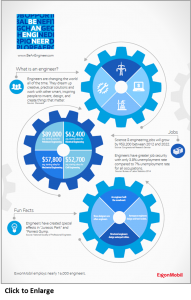
That troubling fact helps explain why there are currently millions of vacant jobs across our nation, even as the number of Americans not in the labor force is the highest it’s ever been.
There simply are not enough applicants with adequate skills to fill many of the most promising positions available in the 21st century. This lack of skills is especially acute in jobs that increasingly rely on science, technology, engineering, and math.
This set of circumstances is worrisome for science-based companies like ExxonMobil, of course. But more broadly it is troubling for America’s future competitiveness in the global economy.
To help address this predicament, ExxonMobil has launched a nationwide initiative seeking to inspire the next generation of engineers. Our Be an Engineer campaign aims to highlight the meaningful contributions that engineers make to the world, as well as provide resources to assist young people interested in pursuing the profession.
In the weeks and months ahead we’ll be running a number of commercials on television in support of this effort. You can catch them at ExxonMobil’s YouTube channel as well.
Over the next few weeks I will occasionally turn this space over to guest bloggers who will share their experiences as engineers and why engineering can make for a rewarding and valuable career. Among them is Dan Mote, longtime educator and currently the president of the National Academy of Engineering.
Today, though, I want to share with you a few thoughts on the state of engineering in America offered by our Chairman and CEO, Rex Tillerson.
Rex is an engineer himself, with a degree in civil engineering from the University of Texas. These remarks, culled from various interviews and speeches he has given the last few years, are instructive for why we are pushing ahead with our Be an Engineer initiative:
We’ve got to help young people understand how exciting the world of the engineer is to be able to create things that have never been created before. …
One of the challenges we’ve had as a profession is that young people don’t really know what an engineer does. And it can take on a certain connotation of being nothing more than a technician, when in reality scientists discover things and help us understand why they are. Mathematicians help us calculate and measure. …
Engineers are the marriage of science and mathematics. We take those two things, we put them together and we create everything around us, from your iPad to this building we’re sitting in to the medium that we’re broadcasting to people today to the houses we live in to the cars we drive. They are all engineering products.
I am confident that the more that young people actually learn what engineers do and accomplish for society, the more they will be drawn to pursuing careers in that direction.
Solar Eclipse
If you are in the Wisconsin area on Thursday, October 23, 2014 please come by Yerkes Observatory in Williams Bay Wisconsin to view the partial Solar Eclipse. Yerkes is a Legacy Partner of my STEM outreach program and I can guarantee the experience will be well worth the trip!
Yerkes Observatory Solar Eclipse Event
Yerkes Observatory in Williams Bay, Wisconsin is offering a special opportunity for people to safely watch a partial solar eclipse: an astronomical event where the moon passes between the earth and the sun, appearing to block out part of the sun. This phenomenon is relatively rare to see.
The program will run from 4:00–6:00 pm on Thursday, October 23rd (the eclipse itself begins just after 4:30 pm). Various solar viewing instruments will be available for safely watching the eclipse. Some eclipse related activities will also be provided. We encourage people to arrive promptly at four, but that is not required; we will be open throughout the event. The event will occur regardless of weather.
The cost for this event is $5 per person, or maximum of $15 per family. Pre-registration is appreciated. Children must be accompanied by adults. No pets, please.
To register or for more information, please visit http://astro.uchicago.edu/yerkes/, and follow the link on the home page.
Throughout the year Yerkes is open for free public tours on Saturday mornings, as well as offering special group tours and various programs. Other events at Yerkes are also posted on the website given above.
Time to Change the Paradigm of STEM Learning
We’ve struggled for a very long time to find the answer to why students aren’t interested in science and math. The usual response I get from students when I ask them how do they like their science or math class is, “It’s too hard or it’s too boring.” After asking this question thousands of times to students in various grades from primary to high school, I am beginning to understand the problem.
We don’t make STEM learning fun, we don’t make STEM learning exciting, and we don’t make STEM learning engaging. I’ve said for the last ten years that STEM is the new buzz word. You can’t go to any science conference today and not have sessions devoted to STEM. In many cases, the entire conference is a STEM conference. And what do you see there? The same vendors and publishers you saw years ago at the same conferences with, in many cases, the same products and books that have been updated to reflect the current science and technology. Chemistry is chemistry as a class and even I found chemistry not fun when I was in high school. Now I understand why. My chemistry teacher was not only boring but he could care less about engaging us in doing chemistry. You can’t learn chemistry or biology or physics from a textbook yet in many schools that’s just how the students are expected to learn. Read the chapter and answer the questions at the end of the chapter.
How exciting is that? Not at all. It doesn’t matter about the shortage of qualified STEM graduates and that the biggest opportunities for our students in future career fields is in STEM. We lose them before we can really capture and engage them to love STEM. To do this however, we have to change the paradigm of how we teach STEM and quit calling science STEM or technology STEM or mathematics STEM just because these subjects are part of the acronym. You have to take everything, including the engineering component and mash it up into fun learning that still meets the standards and hopefully will increase standardized test results. You also have to capture a child’s imagination and creativity on an individual level one student at a time.
As educators, we too often don’t think to ask students what they want to learn in a STEM class or what projects, research, investigations, coding, game or webdesign, etc. they would like to take on. We have the standards and we have to teach to those benchmarks and we have textbooks with content and lessons, and activities anyway so why would we want to deviate from what we’ve been doing in the past?
Because. This is an answer I used to give my son all the time. Very simple yet very powerful. Here is my list of reasons that would follow:
1. We can’t afford not to.
2. It’s time to flip the classroom and not just with technology.
3. “What If” is the most basic question of human existence and one that has fostered invention and innovation since the dawn of time.
4. Put engineering in or don’t call it STEM. It can be STM or S or T or M but not STEM unless you have engineering lessons and activities in your lessons as well.
5. Don’t follow what everyone else is doing. As a teacher, be your own creative resource and step out of the box.
6. You have to be a lifelong learner and learn the hard stuff to.
7. Play more. My motto has always been, “If I’m not having fun you aren’t either.”
8. Don’t try, do.
As we prepare for another school year, take these words of wisdom into your classroom and be the change that you want to see in your students. Smile, laugh, engage, captivate, motivate, and inspire. Have a great start to your STEM school year.
NASA’s Next Giant Leap: Comic-Con 2014
It’s now official. When NASA comes to do a panel at Comic-Con, the once geeky comic book, action figure, and superhero film convention where if you aren’t dressed up as some character, person, or alien from popular comic fiction, you’re not cool. I didn’t make it to Comic-Con this year and missed this panel. After watching this mix of NASA planetary science and engineering and the commentary/questions from the Comic-Con panel facilitator Seth Green, I realized that STEM has moved from the textbooks, the SmartBoards, the classrooms, and even the iPads (that can be seen in the video held high to record the panel) to a new audience of people.
OK, maybe not a totally new audience. The people who attend Comic-Con are serious about their comics, the art, the movies, the collectibles, the celebrities, the robots, and the science. It’s cool (yes I said cool) to hear the enthusiasm of Seth in questioning the panel that included NASA astronauts Buzz Aldrin and Mike Fincke, NASA Planetary scientist Dr. Jim Green, and “Mohawk Guy” Bobak Ferdowsi ( (Seth) ” You landed a car on Mars!”) It’s also a great way to give NASA exposure beyond the traditional press conferences, the educational webinars, and even the NASA web portal. The panel marked the 45th anniversary of the Apollo 11 moon landing and it is great to see these guys talking about planetary exploration, space, dreaming of becoming an astronaut, planning the next Mars robotic rover mission, 3-D printing, building habitats on Mars, and the future of exploring the final frontier.
The wonderful folks at NASA’s Jet Propulsion Laboratory are the genius minds behind this. The conversation of space exploration and engineering innovation and what we can look forward to for the next 45 years is fantastic. Questions from the children are priceless especially the little girl who asked Buzz Aldrin, “What made you want to go to space? What inspired you?” Watch the panel, enjoy, and be inspired!
A New Paradigm
While working on a new project, I heard someone on television mention China and I thought about a truly wonderful experience I had with a group of young people when educational technology was in its emerging phase. This post is from my Innovate & Educate blog and was written in June 2010.
Welcome to the Innovation Education blog. Twenty years ago when I made the leap from corporate America to education I had one goal in mind, to share the experiences I had learned in business and open up new ideas and career options for my students. Many of us have done innovation centered education projects in our classrooms without realizing that was what we were doing. In 1999, I gathered a group of students to participate in the AT&T Virtual Classroom Contest. Each virtual classroom was comprised of three schools from different countries. Our partner schools came from Canada and Japan. Everyday after school, my students would come into the computer lab and work on our submission. The students had to create a collaborative website with an educational focus and we had to use technology tools. We had the old school version of Skype, Cu-See-Me, the newest Macintosh computers with Adobe
PhotoShop and Illustrator, and Macromedia Flash, which was taking the Internet to a  new level of animation. After discussing the project for a month, we decided to create an online television station.
new level of animation. After discussing the project for a month, we decided to create an online television station.
Thus NetVision was born. The project was a combination of videos shot by students in each school and combined into unique channels that would be targeted to teenagers. We had a fashion channel, a sports channel, a news channel, and a cooking channel. Content ranged from learning how Sumo wrestlers train, cooking Creole, fashion trends, music, and the most interesting, a day-in-the-life of a teenager focusing on how while we all came from different cultures, backgrounds, and countries teenagers were basically all the same.
The innovation here is there was an opportunity for three diverse groups of students to change the way teenagers could access and receive information, connect with other teens across the world, and collaborate on new ideas and technologies. VC_46 placed third in the secondary category and I was fortunate to travel to Hong Kong to participate in the awards ceremony and spend a week sharing practices and ideas with educators from around the world. Later in the spring of 2000, after the contest was over, our Canadian partners visited our school and we had a huge celebration. That was the end of Netvision but it didn’t have to stop when the contest was over.
It was a great experience for me and my students. Most of the students who worked on the project graduated that year. AT&T pulled out of the Virtual Classroom Contest in 2000 and it was taken over by a non-profit company in 2003. NetVision had incredible possibilities and if some of the students, and teachers (me included), had approached the project after the contest as an opportunity to innovate in the emerging area of streaming video on the Web, I probably would not be sitting here writing this blog. NetVision could have been the beta version of YouTube. We could have even revolutionized a new trend, social media!
I don’t believe in missed opportunities and someone once told me that there are no new ideas. People do re-invent the wheel but they don’t change it totally, they just find innovative ways to make it better. Today, innovation used in context with education is the new buzz. Many will say innovation centered education is nothing more than Project Based Learning (PBL) but if you examine what the word innovate means you will discover that it is much more. Websters definition of innovate is:
Transitive Verb
1. to introduce as or as if new
2 archaic : to effect a change in;
Intransitive verb
3. to make changes : do something in a new way, to introduce as or as if new
When we look at the way we deliver educational content, studies have shown that we have not fundamentally changed our practice in several hundred years. Our students still sit in classes at desks for a specified amount of time each day, use textbooks, complete worksheets, and do homework. Teachers lecture, explain, discuss, and demonstrate concepts and skills that measure learning by students achieving skills at benchmark grades and showing proficiency at or above each grade level based on local, state, and national learning standards.
Passing tests is one thing. Equipping our young people with the skills they will need to effect change in our society, in developing the products we use, in our expanding global economy, re-building our country’s highways and transportation infrastructure, and in the way we discover the unknown cannot be done in the traditional way of textbooks and worksheets. It is therefore imperative that a paradigm shift in the way we teach and in the way our students learn occurs.
Giving Thanks to Space, Students, & the Importance of Inspiring the Next Generation of Innovators
Happy Thanksgiving! I can’t think of a better way to spend my Thanksgiving morning than responding to my Twitter family and discovering wonderful projects that will not only move us forward in our journey into space exploration but inspire young people to realize these are really cool careers and there has never been a bigger opportunity for anyone interested in anything space related to have a chance to be part of the next exploration frontier.
Check out this fantastic group of students from Canada, @SpaceConcordia, and the work they are doing. They won the Canadian Satellite Space Design Challenge in 2012 and they are now working on a satellite that can heal itself if it is damaged in space for the competition this year. These are the kinds of innovations that will be needed as we begin to plan for human exploration into space whether it is low Earth orbit, in our Solar System, or beyond. Materials science is an area of STEM that I have begun to do work in with my educational outreach and while designing, building, and prototyping robots, moonbuggys, race cars, and rockets is always fun, the materials they are made out of are key to these mechanical creations be successful.
They have three days to go on their Kickstarter campaign. I’ve made a contribution because I believe that it will take all of us who work in STEM education outreach, the space industry on all continents, and the forward thinkers who never believe in the word can’t but find a way to be able to prove they can. I’ve been blessed over the years to have some wonderful people, government agencies, corporations, and non-profits support my dreams in working with students in urban communities to realize they can dream big and the sky is no longer the limit.
STEM & The City
Today is the start of our third year of NASA Summer of Innovation programming. We were awarded a second year mini-grant to continue our “There’s An App for That!” STEM program. This year we will be working with several community partners and Chicago Public School summer programs to introduce programming and engineering to middle school and rising 9th graders.
Thirteen years ago NASA came to Chicago to inspire and ignite the imaginations of K-12 students in Chicago Public Schools. SEMAA (Science, Engineering, Mathematics and Aerospace Academy) was a program that was literally out of this world. Chicago students had an opportunity to learn about space, aeronautics, engineering, design, our Solar System, our planet, and concepts that we just don’t teach at the middle school level about our Moon, our Sun, and the excitement of planetary exploration as the final frontier.
This year we thank NASA for allowing us to continue our work with inner city youth to inspire them to say, “Wow!” I have done my intro activity on the Universe hundreds of times with students, teachers, and adult participants. I have been on a personal fact-finding mission for the last eight years in putting my finger on where the disconnect occurs with students either loving or hating science and math. Sometimes these conversations were casual with students in the classroom and others were part of programs or workshops I conducted. This year I am going to add a new twist by posting what the young people say and visualize about our Universe, our Solar System, our Moon, our Sun, and most importantly the planet on which we live.
Misconceptions are hard to overcome because once we are told or make our own assumptions about science it is hard for us to change what we thought was true. Managing the SEMAA program in Chicago was a very special time in my life. As an educator, I know .we impact the lives and imaginations of our students but in most cases we never understand the depth of what we have accomplished. A year ago a man came up to me at a Chicago Public School board meeting and said hello. He then went on to tell me his granddaughter had been part of the SEMAA program and that she was now in college studying engineering. “She talks about you all of the time,” he said. She also tells her friends how coming to those SEMAA classes made her want to study science and engineering.” He continued to recount some of the more interesting things about the program as well as how I wore every hat under the Sun but as he talked I remembered his granddaughter and while we did not track our students I felt incredibly happy that SEMAA had planted a seed for her that she continued to cultivate.
And that’s what it’s all about. Planting seeds and engaging young people in learning STEM in ways that are non-traditional and fun. We have got to change the landscape of what was and what is to what can be. We need more girls in science and engineering and the classrooms, workplaces, and boardrooms need to reflect this as well. I talk to many female engineering students at IIT where our FIRST Robotics team is located and they all say the same thing. There are far too few females in their classes but they hold their own. We need more ethnic diversity as well. We can make this happen but it will take the collective work of many along with a determination to make the changes necessary one child at a time.
This is my mission and I am proud to accept and continue the challenge of “Inspiring the Next Generation of Explorers as Only NASA Can!




